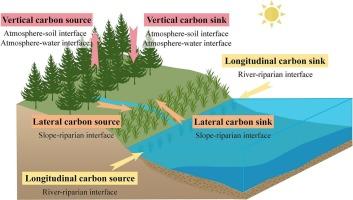A three-dimensional coupling evaluation model for carbon source-sink in riparian zones
IF 6.3
1区 地球科学
Q1 ENGINEERING, CIVIL
引用次数: 0
Abstract
Riparian zones, with high carbon sequestration capacity, play a critical role in watershed carbon cycles. Current riparian carbon sink assessments primarily focus on drawdown zones or only consider riparian ecological process, neglecting hydrological process. The objective of this study is to develop a three-dimensional coupling evaluation model for riparian carbon source-sink integrating ecological and hydrological processes, which include vertical, lateral, and longitudinal dimensions. (i) Vertical carbon source-sink: carbon release via respiration and carbon sequestration via photosynthesis. (ii) Lateral carbon source-sink: carbon loss via slope runoff erosion and carbon interception through soil conservation. (iii) Longitudinal carbon source-sink: carbon depletion by riverbank scouring of runoff and carbon sequestration by fluvial sediment deposition. Applied to the Fuhe River, the results show that: (i) The riparian zone of Fuhe River is a net carbon sink (593.0 t·a-1), with an economic value of 25,410.1 CNY. Vertical carbon process is a net carbon sink (5,657.0 t·a-1), while the lateral and longitudinal processes act as net carbon source (2,607.0 and 2,457.0 t·a-1, respectively). (ii) By riparian zone sections, the water-level fluctuation zone acts as a net carbon source (3,680.3 t·a-1), while the riverbank zone functions as a net carbon sink (4,273.3 t·a-1). (iii) Spatially, the upstream and midstream are net carbon sinks (513.04 and 234.35 t·a-1, respectively), while the downstream is a net carbon source (154.41 t·a-1). (iv) Enhancing vegetation coverage to boost photosynthetic capacity is key to increase carbon sink, and strengthening soil conservation measures to cut organic carbon loss from soil erosion is crucial for reducing carbon source.

河岸带碳源-汇三维耦合评价模型
河岸带具有较高的固碳能力,在流域碳循环中起着关键作用。目前的河岸碳汇评价主要集中在汇减带或只考虑河岸生态过程,忽视了水文过程。本研究的目的是建立一个包含垂直、横向和纵向三个维度的河流碳源汇耦合评价模型。(i)垂直碳源-汇:通过呼吸作用释放碳和通过光合作用固碳。横向碳源-汇:通过坡面径流侵蚀造成的碳损失和通过土壤保持造成的碳拦截。(三)纵向碳源-汇:河岸冲刷径流造成的碳消耗和河流沉积物沉积造成的碳固存。结果表明:①抚河河岸带是一个净碳汇(593.0 t·a-1),经济价值25410.1元;垂直碳过程是净碳汇(5,657.0 t·a-1),而横向和纵向过程是净碳源(分别为2,607.0和2,457.0 t·a-1)。(ii)从河岸带剖面来看,水位波动带为净碳源(3,680.3 t·a-1),河岸带为净碳汇(4,273.3 t·a-1)。③空间上,上游和中游为净碳汇(分别为513.04和234.35 t·a-1),下游为净碳源(154.41 t·a-1)。(四)增加植被覆盖度以提高光合能力是增加碳汇的关键,加强土壤保持措施以减少土壤侵蚀造成的有机碳损失是减少碳源的关键。
本文章由计算机程序翻译,如有差异,请以英文原文为准。
求助全文
约1分钟内获得全文
求助全文
来源期刊

Journal of Hydrology
地学-地球科学综合
CiteScore
11.00
自引率
12.50%
发文量
1309
审稿时长
7.5 months
期刊介绍:
The Journal of Hydrology publishes original research papers and comprehensive reviews in all the subfields of the hydrological sciences including water based management and policy issues that impact on economics and society. These comprise, but are not limited to the physical, chemical, biogeochemical, stochastic and systems aspects of surface and groundwater hydrology, hydrometeorology and hydrogeology. Relevant topics incorporating the insights and methodologies of disciplines such as climatology, water resource systems, hydraulics, agrohydrology, geomorphology, soil science, instrumentation and remote sensing, civil and environmental engineering are included. Social science perspectives on hydrological problems such as resource and ecological economics, environmental sociology, psychology and behavioural science, management and policy analysis are also invited. Multi-and interdisciplinary analyses of hydrological problems are within scope. The science published in the Journal of Hydrology is relevant to catchment scales rather than exclusively to a local scale or site.
 求助内容:
求助内容: 应助结果提醒方式:
应助结果提醒方式:


